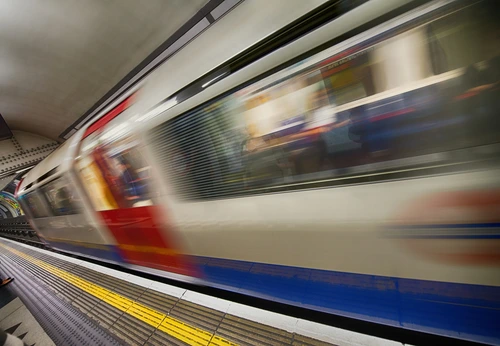
The average London Underground user’s need for speed is a phenomenon as remarkable as the notion of shoving steam trains underground in the first place. Dog-eat-dog capitalism in its truest form, the cavalier, arge-barge willingness of tube users to do anything they can to arrive at their destination 0.45 seconds earlier is formidable. Escalator jousting can only get you so far in this world, however. What you really need to know is which tube line is the fastest.

This, one would imagine, would be a simple case of looking at TfL’s official figures and forever remaining content that your dinner party knowledge is a cut above everyone else’s. But TfL remains coy about the speed of its services. The official website gives a figure for the average speed on the London Underground – 20.5mph, or 33kph – but no more detail than that.
To make any serious estimation of the fastest tube line, then, we must look to other sources.
There are two useful bits of information we do have – how long the tracks that comprise each line are, and how long it generally takes to do the whole thing in one go.
To take one of the simple, branch-free lines as an example, the Jubilee runs between Stanmore and Stratford, along a total 22.5 miles of track. If you log onto TfL’s journey planner, shove it a short time into the future so it can’t account for any live service disruptions, and go, it’ll tell you that the journey takes 57 minutes.
Do the maths, and that’ll tell you that (in theory) the Jubilee line’s overall average speed is 23.7mph.
In theory, you can follow that line of inquiry for each line, accounting for the spurious branches of lines like the Central, Northern, Piccadilly, Circle, District and Metropolitan, and come up with a rough estimate for the average speed of the line based on how long it takes to get from one end to the other.
Helpfully, Michael McHugh did just that and came up with this bar chart to show the results.

The Central line is allegedly fastest, the Victoria and Jubilee are second and third fastest, and the Circle languishes at the bottom of the table.
But it’s hardly that illuminating. Some lines have stops closer together, and others have a habit of dithering in certain stations for a while along the way (think lots of District line trains in Earl’s Court).
Indications of where on the network the tube goes especially fast
The longest gap between two stations is on the north-western end of the Metropolitan line, where the gap between Chesham and Chalfont & Latimer is 3.9 miles. It’s on this part of the network that some of the tube’s true lovers – its anorak admirers – have gone out and measured speeds with amateur GPS devices.
As the network is above ground at this point (as it is for approximately 60% of the entire London Underground system, ironically), you get pretty good signal, so you can clock up the speed that the train is travelling at.
With the old A-stock trains (the ones retired when the shiny, walk-through S7/S8 trains were introduced on the Hammersmith & City, District, Circle and Metropolitan lines), speeds of around 70mph have been allegedly recorded in running service – the allegedly is important, though. None of this is official test conditions, and it’s mostly the handiwork of a bloke spending a Saturday afternoon as God intended.
Disclaimer having been said, that’s an impressive speed, and it’s likely that this is the fastest part of the network. When you’ve got 3.9miles of track to play with, you can bounce along quite merrily before you have to slow down for the next station.
What we don’t have that many of are figures for the newer trains, the S7 and S8 stock. Being newer, the assumption might be that these trains can go faster, but in reality the opposite is true. The S-stock may benefit from faster acceleration than the A-stock trains, at 2.9mph per second; but the top speed is 8mph down on the older models, down to 62mph.
Looking at the maximum speeds that the rolling stock themselves are capable of is a useful tool. The Victoria line’s 2009 stock is capable of 50mph, while the Jubilee line’s 1996 stock can do 62mph, like the new S-stock trains.
The Northern line’s 1995 stock is theoretically capable of 62mph too, as is the Central and Waterloo & City line’s 1992 stock, but in practice this isn’t the case. The Northern line is deliberately limited to 45mph in its underground sections due to the infrastructure of the tunnels, and on most lines you won’t get the chance to go that fast because the stations are too close together.
What really does matter, though, is acceleration – which is why many people assume that the Victoria line is the fastest. While its acceleration is nominally the same as the S7 and S8 stock, at 2.9mph per second, the Victoria line itself was built with hump-backed stations, meaning trains decelerate uphill into stations, storing gravitational potential energy, and accelerate downhill out of them, releasing it and increasing acceleration.
Passenger safety on the tube
In safety terms, too, it’s in passengers interests for trains not to run that fast. The slower trains run, the closer they can safely run together, as stopping a reasonably slow-running train from crashing into the one in front should something go awry is easier than halting a 62mph, 1996 stock from bumping into the back of the next train on the line.
Essentially, if you’re seeking thrills on the Underground underground, hop on the Central or Jubilee lines in their central sections. If you’re a speed-chaser who doesn’t mind being above ground, catch a Metropolitan line out in the sticks. If you’re a fan of acceleration, the Victoria line will give you a quiet thrill.
But if you just like getting from A to B as quickly as possible, the question of which London Underground line runs the fastest probably won’t actually help you that much.
[Read more: Seven things you need to know about using the Paris Metro]






